AFTER THE CULTURAL REVOLUTION IN TIBET
 In 1979, when a delegation from Dharamsala was allowed to visit Tibet, Party officials— seemingly believing their own propaganda—urged Tibetans not to throw stones or spit at the Dalai Lama’s representatives, out of hatred of the old society. But when the contingent arrived it was mobbed by thousands of adoring Tibetans, prostrating themselves and clamoring to touch the Dalai Lama’s brother. A stunned Party chief complained that all the efforts of the previous decades had evidently been no more effective than throwing money into the Lhasa River. [Source: Evan Osnos, The New Yorker, October 4, 2010]
In 1979, when a delegation from Dharamsala was allowed to visit Tibet, Party officials— seemingly believing their own propaganda—urged Tibetans not to throw stones or spit at the Dalai Lama’s representatives, out of hatred of the old society. But when the contingent arrived it was mobbed by thousands of adoring Tibetans, prostrating themselves and clamoring to touch the Dalai Lama’s brother. A stunned Party chief complained that all the efforts of the previous decades had evidently been no more effective than throwing money into the Lhasa River. [Source: Evan Osnos, The New Yorker, October 4, 2010]
After the Cultural Revolution, Tibetans rushed to rebuild the temples and monasteries and reinstate the Buddha's statue among the ruins. The Beijing government eased restrictions on Tibetans briefly during the 1980s, but that respite, along with other political reforms in China, ended with the Tiananmen Square crackdown in 1989. Since then, Tibet’s relations with the capital have reverted to a cycle of confrontation, with Tibetan protests spurring punishment, giving rise to more protest. [Source: Carol J. Williams, Los Angeles Times, June 6, 2013]
Tsering Shakya wrote in New Left Review: “In the 1980s, the CCP purged "three categories of people" who had committed crimes during the Cultural Revolution, but that in Tibet, despite repeated appeals by leaders such as the Panchen Rinpoche, no such purge took place. Hu Yaobang noted in his speech at the Tibet Work Forum in 1984 that he had received written submissions from both traditional leaders and CCP members, urging the Party to expel such people; instead he promoted them, saying they could be reformed. The real reason was that the Communist Party could not find anyone else they could trust to run Tibet so dutifully. The stark contrast between the policy implemented in the TAR and that applied to the rest of China highlights the classic colonial tactic, often observed in Western imperial practice, whereby the hegemonic power seeks to cultivate loyal and servile natives to guard its interests. China rules Tibet differently from China, because there it faces the problems of being a colonial power. [Source: Tsering Shakya, New Left Review, May-June 2002 ^*^]
See Separate Articles: TIBETAN UPRISING AND RIOTS IN 2008 factsanddetails.com ; AFTER THE TIBETAN UPRISING IN 2008 factsanddetails.com ; PROTESTS AND VIOLENCE IN TIBET AFTER THE 2008 RIOTS factsanddetails.com ; SELF-IMMOLATIONS IN TIBET factsanddetails.com ;
RECOMMENDED BOOKS: “Return to Tibet: Tibet After the Chinese Occupation” by Heinrich Harrer Amazon.com; “The Struggle for Tibet” by Wang Lixiong and Tsering Shakya Amazon.com; “Tibet: A History Between Dream and Nation-State” by Paul Christiaan Klieger Amazon.com; “Tibet on Fire: Self-Immolations Against Chinese Rule” by Tsering Woeser and Kevin Carrico Amazon.com; “Tibet's Last Stand?: The Tibetan Uprising of 2008 and China's Response” by Warren W. Smith Jr. Amazon.com; ““I Saw It with My Own Eyes”: Abuses by Chinese Security Forces in Tibet, 2008-2010" by Human Rights Watch Amazon.com; General History: “Tibet: A History” by Sam van Schaik Amazon.com; “A Historical Atlas of Tibet” by Karl E. Ryavec Amazon.com; “Histories of Tibet” by Kurtis R. Schaeffer , William A. McGrath, Amazon.com; “Himalaya: A Human History” by Ed Douglas, James Cameron Stewart, et al. Amazon.com; “Tibet & Its History” by Hugh Richardson (1989) Amazon.com; "Tibetan Civilization" by Rolf Alfred Stein Amazon.com; “The Story of Tibet: Conversations with the Dalai Lama” by Thomas Laird Amazon.com
Tolerance in Tibet After the Cultural Revolution
The 1980s, after the collapse of the Cultural Revolution, was a period of relative tolerance by the Chinese in Tibet in part to make amends for past wrongs. Tibetans were allowed to reopen Buddhist shrines and monasteries. Monasteries destroyed in the Cultural Revolution were rebuilt. The Tibetan language was reintroduced in schools. Rural communes were dismantled and land was returned to private farmers who were allowed to grow whatever they wanted and sell it on the open market. The Chinese leader Deng Xiaoping said all issues cold be discussed except independence.
In many cases the government provided laborers to help rebuild sacred buildings destroyed by the Red Guard. It is not clear, however, whether the Chinese did this as a goodwill gesture or to bring in more tourist dollars. In 1997, there were 1,700 monasteries and 130,000 monks and nuns. The rebuilt monasteries according to Reuter "are more like museums for tourists than genuine places of worship."
The liberal policy was pushed by the Communist party chief Hu Yaobang, who visited Tibet in the early 1980s and was appalled by how destructive Mao's policies had been there. He advocated helping spur economic growth in Tibet and allowing Tibetans to maintain their culture. The Dalai Lama was invited to China. Suspicious of Beijing’s intentions he sent fact finding teams instead. Even though he and the world were dismayed by what the fact finders reported in Tibet the Dalai lama was optimistic.
In 1980, Hu Yaobong apologized to Tibetans in Lhasa for the terrible things the Communist had done in Tibet. He slowed the migration of Han Chinese to Tibet and urged Chinese to leave Tibet to the Tibetans. Unfortunately for Tibetans Hu was ousted from the party by hardliners in 1987. Chinese policy towards Tibet changed after demostrations in Tibet in the late 1980s and after Tiananmen Square in 1989.
Chinese Policy Towards Tibet in the 1980s
The Deng Xiaoping era in Tibet was characterized by a mass influx of settlers beginning in the early 1980s. Cultural and religious liberalization began but Tibet remains securely under Chinese control. But Tibetans continued to complain of widespread discrimination by the Chinese, and the sometimes forcible relocation of Tibetans from traditional communities to new housing developments.
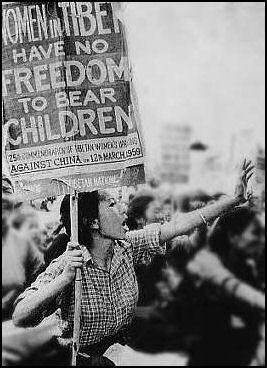 “In 1984, when negotiations stalled,” Evan Osnos wrote in The New Yorker, “China made a momentous change: if the Dalai Lama could not be enticed back to China, then Beijing would buy stability in Tibet through economic development. It approved forty-two major construction projects in Tibet and encouraged other ethnicities to seek work there. Thanks to what Chinese economists called a “blood transfusion” from the East, Tibet now has highways, bridges, and factories on a par with other parts of China. But the influx of non-Tibetans has become a leading cause of unrest.” [Source: Evan Osnos, The New Yorker, October 4, 2010]
“In 1984, when negotiations stalled,” Evan Osnos wrote in The New Yorker, “China made a momentous change: if the Dalai Lama could not be enticed back to China, then Beijing would buy stability in Tibet through economic development. It approved forty-two major construction projects in Tibet and encouraged other ethnicities to seek work there. Thanks to what Chinese economists called a “blood transfusion” from the East, Tibet now has highways, bridges, and factories on a par with other parts of China. But the influx of non-Tibetans has become a leading cause of unrest.” [Source: Evan Osnos, The New Yorker, October 4, 2010]
“In March, 1989, Tibetans in Lhasa held the largest anti-Chinese demonstrations there in decades, in honor of the anniversary of the 1959 unrest that coincided with the Dalai Lama’s flight into exile. The task of restoring order fell to Hu Jintao, a promising young cadre who was the Party boss in Tibet. He asked Beijing to declare martial law and cracked down on rioters. (He was rewarded for keeping the peace. Today, he is China’s President and Party chief.) [Ibid]
In 1989, the year he won the Nobel Peace Prize and hundreds were killed around Tiananmen Square, Beijing authorities invited the Dalai Lama to make his first trip China in decades, to attend the funeral of a high-ranking lama. But his advisers worried that accepting the trip could weaken his bargaining position and he declined, a decision that senior aides now regret. [Ibid]
By this time, Osnos wrote, the “Dalai Lama became increasingly convinced that the quest for independence was doomed, not only because of his belief in pacifism but also because of simple demographics. “A holistic view brings realistic action,” he told me. China is a “huge country. . . . So, therefore, the best way to deal with China is not confrontation but through reason.” In 1988, he publicly abandoned the goal of independence in favor of what he calls the Middle Way, which seeks greater autonomy within Chinese borders. [Ibid]
Chinese View of the Development in Tibet
According to the Chinese government: After the peaceful liberation, the economic construction of Tibet has made great progress, and people's living standard has been improved remarkably. Especially after the democratic reform, the social productive forces of Tibet have got liberated and developed unprecedentedly. The total output value of the whole Region in 2000 was 50 times as much as that in 1959 at the beginning of the democratic reform. Basic facilities have grown out of nothing, and developed and expanded continuously. Agricultural producing has become mechanized. Incomes of residents in urban and rural areas have increased sustainedly, most of the people break away from poverty and some of them live a relatively comfortable life. In 2000, the number of per capita color TV and self-phone of Lhasa occupied the first place all over the Country, and the per capita area of housing also is the highest. Nowadays, Tibet has several hundred modern industrial enterprises including electric power, mining, cement, tanning, machine fixing, wool spinning, food, building materials, printing, etc, and the modernized industry with Tibetan characters has formed preliminarily. [Source: Liu Jun, Museum of Nationalities, Central University for Nationalities, kepu.net.cn ~]
“A road net with Lhasa as the center and the Qinghai-Tibet highway, the Sichuan-Tibet highway, the Xinjiang-Tibet highway, the Yunnan-Tibet highway and the China-Nepal highway as the framework has come into being. Among them, there are 15 main highways, and 315 feeder highways. The highways extending in all directions connect all the counties and 77 percent of the townships of Tibet. Air transportation develops very fast, and construction of the Qinghai-Tibet railway is completed.
During the tenth "Five-Year Plan" (2001-2005), China said it was “going to invest directly 312 hundred million yuans, construct 117 key projects for Tibet, give 379 hundred million financial allowances to Tibet, and different provinces and cities assist 10.62 hundred million yuans. The total money amounts to over 700 hundred million yuans, which could ensure keeping faster developing speed of all economic and social causes of Tibet. The future of Tibet will be more glorious, and life of different nationalities, especially the Tibetans in Tibet will be more auspicious and happier.” ~
“The living standards of the Tibetan people have been rising steadily. The peasants, who lived in rickety sheds and never had enough food, have moved into bright and spacious houses with glass windows and stored up more grain and meat than they can consume. Brightly decorated furniture, television sets and cassette recorders have also made their way into the home of former serfs. However, about small percentage of the peasants and herdsmen have not yet shaken off poverty, although their living conditions are better than in the old days.” |
Demonstrations in Tibet in the 1980s
Demonstrations that grew into a near uprising began in September 1987 after the Dalai Lama proposed a peace plan for Tibet in a speech before the U.S. Congress. Young monks from Sera monastery, circumambulating Jokhang Temple, began shouting “Long Live the Dalai Lama” and “Independence for Tibet.” They were joined by bystanders and sympathizers demanding Tibetan independence. Four days later another group of monks and demonstrators shouted similar slogans while waving Tibetan flags. Chinese soldiers reportedly opened fire on them. A Chinese police station was burnt to the ground. Afterwards, additional Chinese police and armed troops were sent to Tibet.
The largest Tibetan pro-independence demonstration occurred in March 1989, during the Monlam Festival in Lhasa, to commemorate the uprising in 1959. Thousands of protesters took the street. At least 75 people were killed and hundreds were arrested in three days of clashes between Tibetan demonstrators and Chinese security forces. Afterwards authorities imposed martial law and PLA troops were dispatched onto the streets and in villages and the Dalai Lama told demonstrators to return to peaceful protests.
The Communists cracked down hard on pro-independence supporters after 1980s protests. Demonstrations against Chinese rule nevertheless continued, and other countries have increasingly raised the issue of human-rights violations in Tibet and pressured the Chinese government to moderate their stance in the region.
Crackdown in Tibet After Demonstrations in the 1980s

Pro-Tibet protest in Toronto Several protests in Tibet in the late 1980s and early 1990s were violently suppressed by the Communist government and martial law was imposed in 1989. Martial law lasted for about two years.
Chinese security forces were able to easily crush Tibetan resistance. Each time the Tibetans revolted they were dealt a humiliating defeat. "Tibetan independence is fueled mostly by misguided people in Congress and Tibetans in exile," a Western analyst told the Washington Post. "It is a crime to encourage Tibetans to think they will gain independence. It's not going to happen.”
The Communist Party leader in Tibet at that time of the crackdown was Hu Jintao, the current president of China. He is not remembered for being particularly harsh or being particularly sympathetic to the Tibetan cause. Most say he simply followed orders.
According to one biographer Hu Jintao made himself unavailable during the initial riots in 1989 and paramilitary police reportedly took matters into their own hands and crackdowned on protesters without orders from Hu. In this way Hu got credit for restoring order but also protected himself in the crackdown failed. Around this time Hu caught the eye of Deng Xiaoping and was appointed to the Politburo Standing Committee, paving the way for him to become leader of China.
After 1989 Beijing moved swiftly to consolidate its powers by taking control over Tibet’s Buddhists the best they could and diluting the authority of the Dalai Lama. Security forces were sent to the monasteries and “Democratic management committees” were established in them. Police stations were opened outside the major monasteries.
Tibet Under Chen Kuei Yuan
Chinese rule in Tibet was particularly repressive from 1993 to 2000 when the Communist Party chief for Tibet was Chen Kuiyuan. In 1997 he declared that Buddhism, which had been around for 1,000 years, was "foreign" to Tibet.
Robert A. F. Thurman wrote: Direct orders of the aging Chinese leadership placed Tibet under the control of an aggressive administrator named Chen Kuei Yuan. Chen proclaimed that the Tibetan identity had to be eradicated in order for remaining Tibetans to develop a Chinese identity. Since Tibetan identity was tied up with Tibetan Buddhism, Tibetan Buddhist culture was in itself seditious, or "splittist," as the Chinese call it. [Source: Robert A. F. Thurman, Encyclopedia of Genocide and Crimes Against Humanity, Gale Group, Inc., 2005]
“Chen also was able to use China's growing economic power to invest heavily in internal projects in Tibet, bring in millions more colonists, and he extracted unprecedented amounts of timber, herbs, and minerals from the land. He also toughened up the policies of the People's Liberation Army and the Public Security Bureau. |~|
Tensions and Violence in Tibet in the 1990s and 2000s
Renewed suppression took place in the 1990s with intensified population transfer of Chinese settlers. In recent decades a significant number of Chinese immigrants have moved to Tibet, and Chinese now constitute the majority of Lhasa's population. A report released by Human Rights/Asia in 1995 said: "In its drive to crush dissent, the Chinese state is widening the range of discontent, increasingly criminalizing the process of political criticism, and imprisoning more ordinary Tibetans than at any time since the late 1980s." There was a "renewed crackdown on religious activities, torture of independence advocates and dramatic escalation of arrests."
Tibetan women with scarves gagging their mouths marched to protest the repression in their homeland. A riot broke out in Lhasa after a Tibetan man at a Muslim Hui restaurant found "a long fingernail" in his dumplings and shouted "They're serving human flesh!" There was an unconfirmed reports that seven Tibetans were killed and 60 were badly wounded in violence during a pro-independence protest at a prison in Tibet in May 1998.
In 1998, after months of research in Tibet, the Chinese writer Wang Lixiong noted that the region “is more prosperous now than ever before in its history. However, this has not gained the People’s Republic of China the allegiance of the Tibetans, more and more of whom have become attached to the Dalai Lama.” In another piece, Wang warned, “The present stability is superficial.” For his writings on Tibet and elsewhere, he was eventually placed under house arrest.
See Human Rights, Government
See Serthar, Tibetan Buddhism and Sects
Repression Ebbs and Flows in Tibet
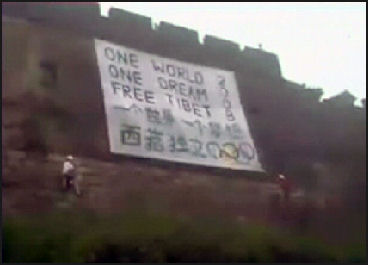
Unfurling banner at the Great Wall in 2007
The selection of Hu Jintao as the president of China in 2003 has given some Tibetans some hope since he was the governor of Tibet in the late 1980s and has first hand knowledge of Tibet. Many regard him as open minded and may support more liberal policies. The removal of a hardline local party chief in 2000 was also viewed as a good sign by many Tibetans.
In recent years there has been cycles of repression and easing of repression. By the mid 2000s, Beijing was restoring temples and monasteries and helping pilgrims. The official position seemed to be that the government had nothing against Buddhism or practicing religion as long as worship was not politicized. Beijing, however, continued its hard line stance on the Dalai Lama.
Pictures of the Dalai Lama became increasingly common sights in homes and sometimes in out of the way corners of temples. Monks kept picture of him under their robes like Christian scalpulars. While Beijing didn’t like them it didn’t raid homes or do body searches to find them either.
Tibetans caught trying to escape from Tibet were not dealt with as harshly as they were a few years earlier. One monk told the Washington Post he was caught by guards at the border while trying to escape to India. Instead of being imprisoned or punished in another way he was simply driven back to his monastery. Monks accused of pro-independence activities were only required to attend patriotic education classes.
In the summer of 2006 repression was stepped up. NGO operations were curtailed; Tibetan-themed blogs were shut down; workers were forced to write criticisms of the Dalai Lama. Some analysts believed that the move showed division in the Communist leadership over recent moves by the Dalai Lama and the arrival in May 2006 of a new party secretary for Tibet, Zhang Qingli, a hardliner and a friend of President Hu Jintao.
In late 2007 there were reports from the London-based Free Tibet Campaign that Tibetans were being forced to sign a petition opposing the Dalai Lama’s return to Tibet.
See Easing of Tensions Between Tibet and Dalai Lama, Dalai Lama
Politics, China and Religious Activity in Tibet
According to the Encyclopedia of Buddhism: Since the opening of Tibet after the Cultural Revolution, there has been a resurgence of Buddhist practice. The Chinese have resurrected religious buildings — the Potala, Norbulinka, the Jo khang, and so on — as museums for tourism, and Tibet's cities have become Han Chinese enclaves, but Buddhism is thriving in the countryside. Ever suspicious of religion, the Chinese have sought to control monastic construction and the number of clergy. [Source: Encyclopedia of Buddhism, Gale Group Inc., 2004]
The participation of monks (and foreign sympathizers) in insurrections has exacerbated Beijing's mistrust. Even then, individual teachers have temporarily managed against great obstacles, although their building efforts are often dismantled. Certain lamas find allies in Han businessmen, who provide capital and political legitimacy to construction projects. China has also played politics with the process of reincarnation, installing its own Panchen Lama and incarcerating the Dalai Lama's choice. More curiously, Tibetan publishing has taken off in the People's Republic of China since Mao's death, making many rare chronicles available for the first time. |~|
Religious tensions were again underscored in 1995 when China rejected the boy who was confirmed by the Dalai Lama as the new Panchen Lama and forced the selection of a different boy and in 2000 when the 14-year-old Karmapa lama fled Tibet for India. “The continued tug-of-war between the Dalai Lama's government in Dharamsala and Beijing over human rights and religious freedom is in part incomprehension by Beijing, in part stalling tactics until the Dalai Lama's death.
Protests in Tibet in the 2000s
Tibetan demonstrations follow a similar pattern. Monks usually take the lead and lay people support and protect them. In 2006 there was some violence at Ganden monastery near Lhasa when monks showed veiled support for the Dalai Lama in a dispute over a clay statue of an obscure deity. Beijing responded by accusing the Dalai Lama of ‘sabotaging the unity of Tibet.” At Sera monastery a monk reportedly hung himself to avoid signing a paper criticizing the Dalai Lama. In October 2006, several hundred young educated Tibetan gathered in front of the local government administrative building in Lhasa to protest the fact that they were educated and qualified but jobs went to Han Chinese not them.
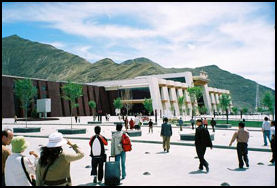
New train station in Lhasa
In August 2007, about 200 supporters of the Dalai Lama who called for his return were arrested by police in Lithang, an ethnic Tibetan area in Sichuan Province, where people had gathered for a horse festival. The incident was triggered when a local Tibetan nomad named Runggye Adak spoke about the Dalai Lama in public. In November 2007, Adak was convicted of “trying to split China” and “subversion” for shouting “long live the Dalai Lama” at the horse festival.
Around the time of the beginning of the one year countdown to the start of the Olympics, large anti-Chinese, pro-Tibetan protests were staged in New Delhi; a huge banner protesting the Chinese presence in Tibet was hung on the Great Wall of China; and a pro-Tibetan activist shouted questions members of the International Olympic Committee (IOC) when they visited Beijing. The foreign protesters who hung the banner and the activist who harassed the IOC were deported on a plane to Hong Kong.
In 2007 and 2008 there were several demonstrations staged by non-Tibetans in China held in connection with the Olympics. In April 2007, Chinese authorities arrested four pro-Tibetan protesters who had hiked to Mt. Everest base camp and hung a banner to protest the Olympic torch relay through Tibet. Around the same time a soccer match between players form India and Tibet was staged in Delhi to protest the Beijing Olympics. See Olympics
In October 2007, Tibetan exiles stormed the Chinese Embassy in New Delhi, India to protest new religious restrictions implemented a month earlier. About 30 to 50 protesters participated, including some maroon-robed monks who chained themselves to the flagpole inside the embassy before they were arrested. Beijing blamed the Dalai Lama for instigating the attack.
Significant new protests and riots erupted in Tibet and among Tibetans in neighboring provinces in 2008 and to a lesser degree in Tibet in 2012. See Tibetan History, Uprising in 2008, Olympics
Economic Improvements in Tibet
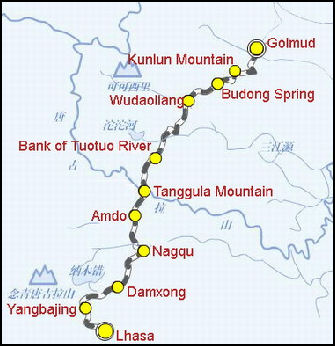 The Chinese have poured a lot of money, time and energy into modernizing and developing Tibet. Since 1959 the Chinese government has spent more than $30 billion in Tibet and increased life expectancy from 35.5 to 67 years and raised GDP from 142 yuan to 13,861 yuan. In recent years, helped by subsidies, the economy in Tibet has grown in double digit numbers, higher than those of China as a whole. Between 2001 and 2005, Tibet experienced average annual growth of 12 percent.
The Chinese have poured a lot of money, time and energy into modernizing and developing Tibet. Since 1959 the Chinese government has spent more than $30 billion in Tibet and increased life expectancy from 35.5 to 67 years and raised GDP from 142 yuan to 13,861 yuan. In recent years, helped by subsidies, the economy in Tibet has grown in double digit numbers, higher than those of China as a whole. Between 2001 and 2005, Tibet experienced average annual growth of 12 percent.
GDP reached 21.2 billion yuan (almost $3 billion) is 2004, a 19 fold increase from 1964. Much of the increase was attributed to government aid and the influx of Han Chinese who have created more economic opportunities, mostly for themselves but also for some Tibetans too. The opening of the railway to Tibet helped boost growth to 13.2 percent in 2006.
Economic reforms have raised the standard of living of many Tibetans. Large numbers have also been left out. Annual income quadrupled to $1,076 between 1986 and 2006. Yet unemployment has remained at around 10.3 percent, higher than the rest of China. Many of the unemployed are Tibetans, some of whom hang out at pool halls during the day and get drunk at night.
Beijing seems to be banking on the idea that economic prosperity will weaken the ties between Tibetans and their culture and religion and make it easier for the government to control them. But there are limits. One Tibetan truck driver told the Times of London, “Our lives are much better now — we can afford our own houses. It’s just that I don’t like the Chinese government.”
New Tibetan Train
A 1,142 -kilometer railway between and Lhasa and Golmund in Qinghai Province — which is connected to the national rail system — opened in July 2006. The highest railway in the world, it reaches an elevation of 5,072 meters, surpassing Peru’s Lima-Huancayo line which reached 4,800 meters, and cost $4.2 billion to make. About 960 kilometers of tracks run 4,000 meters above sea level. During these sections, oxygen is released into the carriages to ease the passengers' altitude sickness. About 550 km is also on frozen earth, the longest distance of any plateau railway. Reducing the journey from Golmund to Lhasa from three days to 15 hours, the new Tibetan train features specially-designed cars, pressurized like aircraft, with filtered, sealed windows to protect passengers from ultraviolet rays and oxygen supplies to prevent passengers from getting altitude sickness and help them with the thin air. Former Chinese Premier Zhu Rongji called it “an unprecedented project in the history of mankind.”
The first section of the Qinghai-Tibet Railway - from the capital Xining to Golmud in the west of the province - was opened in 1984, with the second section - Golmud to Lhasa - started in 2001 and completed in 2006. An extension from Lhasa to Tibet's Xigaze prefecture is already under construction, while work on an additional link to Nyingchi prefecture in southeast Tibet will start during the 12th Five-Year Plan (2011-2015). "When all extensions are finished, the railway network will be the first in Tibet and will really improve Tibetan people's lives," a Chinese official told the China Daily.
The railroad has been on the drawing boards for some time. Mao ordered feasability studied in the 1950s but the plans to build it were scrubbed due to engineering problems, lack of money and unrest in Tibet. A new rail line reached Golmud, the gateway to Tibet in 1984, but was prevented from continuing further because of permafrost and extreme cold.
Construction began in 2001 after methods for tunneling through ice and laying track on permafrost were worked out. The first 120-kilometer leg was complected in 2003. Once the operation was in full gear track was laid at a rate of about one kilometer a day. The first cargo trains went into operation on a limited basis in 2004.
See Separate Article TIBETAN TRAIN: ITS ROUTE, CONSTRUCTION, IMPACT ON TIBET AND TOURISM factsanddetails.com
Zhang Qingli
Zhang Qingli, the party secretary for Tibet in the 2000s, was a protégée of Hu Jintao. Tibetans didn’t like him and it was not hard to understand why. He denounced the Dalai Lama, using very insulting language, stepped up patriotic education and dismissed Tibetan Buddhism as “an abstract” to “establish a normal order.” He described his mission in Tibet as an effort a “fight to the death struggle” and "a fierce battle of blood and fire with the Dalai clique.”
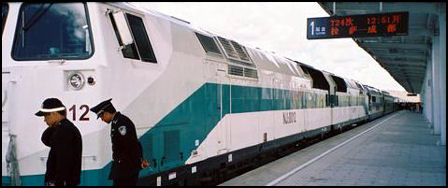
Zhang once said, “The Communist Party is like the parent to the Tibetan people and it is always considerate about what the children need. The Central Party Committee is the real Buddha for Tibetans.” He has called the Dalai Lama “a jackal in Buddhist monk’s robes, an evil spirit with a human face and the heart of a beast.”
Zhang made a name for himself in Xinjiang, where he was involved in implementing policies that were arguably even harsher than those in Tibet. In Xinjiang and Tibet he instituted a zero-tolerance policy in which small incidents were been treated as major threats to the government. One political analyst told AFP, “The things that he has done and the threatening and violent language he uses have been very disturbing.” Another said, his policy’s aim seem to be “to wipe out Tibetan culture and assimilate it into the mainland.”
Image Sources: History in Pictures, Wiki Commons, Save Tibet, Cosmic Harmony, Students for a Free Tibet, Seat 61
Text Sources: New York Times, Washington Post, Los Angeles Times, Times of London, National Geographic, The New Yorker, Time, Newsweek, Reuters, AP, Lonely Planet Guides, Compton’s Encyclopedia and various books and other publications.
Last updated September 2022
